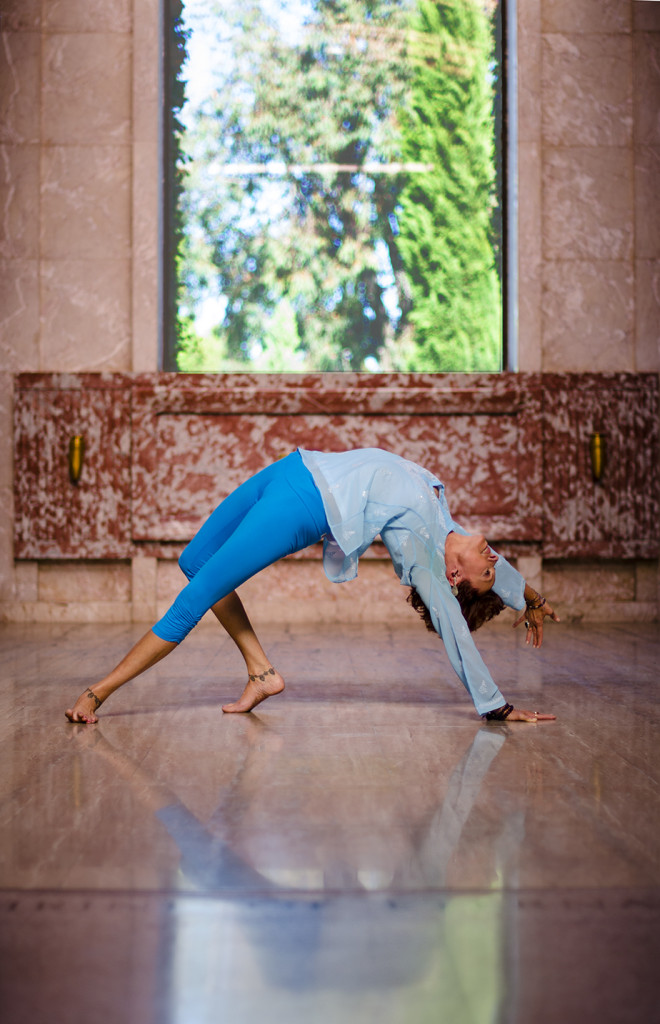
Ev’rybody’s Doin’ a Brand New Pose Now, C’mon Baby, Do the Yoga Motion
Los Angeles is the epicenter of yoga in the Western world, with at least 60 studios, many of which adhere to the spiritual traditions of yoga. But those studios are now far outnumbered by health clubs offering yoga–or some semblance thereof. The number of people who “do” yoga has doubled nationwide since 1996. But here’s the question: How many of these new disciples see the practice as nothing more than the one true path to a firmer butt? Paul Tullis explores this question, quoting Jeanne along the way, for the Los Angeles Times Magazine in its September 21, 2003 issue.
Classes Are Now More Common at Health Clubs Than in Traditional Studios – and There’s Some Bad Karma About the Evolution.
By Paul Tullis is a Los Angeles-based freelance writer, Los Angeles Times
If anthropologists in the next century ever go searching for the exact moment when yoga passed from spiritual endeavor to mere fitness craze, they might well look to a tall, terrifically fit woman in her 30s named Beth Shaw. Concerned that her traditional yoga training had not prepared her to teach in a fitness club, Shaw created a course that promises to churn out yoga instructors in a single weekend, which is no small feat given that yoga is a 5,000-year-old Hindu spiritual practice that attempts physical purification, in part through breathing and exercise, to reach a blissful state called ananda.
Master that in a weekend and you’re ready to learn brain surgery from the back of a cereal box.
In fairness, it’s not as if Shaw doesn’t know her asana from her elbow. She was trained by Ganga White, the man pretty much responsible for bringing yoga to Los Angeles in 1967 when he founded Larchmont’s Center for Yoga. But Shaw didn’t like the austerity of yoga studios, so in the mid-’90s she decided to move into fitness centers. In those clubs, however, she found the traditional training hadn’t prepared her to teach in “a fitness club environment.”
Shaw says she wanted to develop “a user-friendly, fitness-oriented style of yoga.” To that end, she created her weekend course–and succeeded spectacularly. Her company, YogaFit Training Systems Worldwide, has since processed almost 25,000 teachers on five continents. “We’re making yoga popular with people who have been turned off by traditional yoga,” Shaw says.
Visit, for example, the popular West Hollywood health club called Crunch, where a sign by the entrance reads: “Please check all hang-ups about the size of your derriere, regrets . . . self-loathing . . . stress . . . embarrassment . . . worries . . . angst.” Opposite, a video of an appearance on Howard Stern by the leader of the club’s strip-aerobics class plays on continuous loop. In the locker room are men with sculpted pubic hair. Upstairs, a woman with what appear to be DDD breasts and a 22-inch waist works out with a personal trainer near a roomful of people on whom the absurdity of riding a stationary bicycle indoors on a sky-blue, 75-degree, perfect Southern California morning seems completely lost.
Gradually people with yoga mats appear. One woman plugged into an iPod starts busting hip-hop dance moves as she waits. A fit model tells how coming to yoga has made her a lot stronger, though she also likes it for its “peaceful and relaxing” qualities. Which is a surprise considering she can barely be heard over the electronica. They all head into the room where the yoga class will be held (previously occupied by Tunde’s Super Sculpt class, which obviously takes some of its moves from yoga postures). Once the Crunch yogis have filed in, the teacher takes requests for the morning’s practice. Several in the class pipe up in unison: “Abs!”
But if you’re just doing the poses and not meditating, not instructing people on how to breathe, not chanting, are you really doing yoga? Most spiritually inclined gurus will tell you flat-out: No.
But hey, what do they know about toning abs?
Los Angeles is the epicenter of yoga in the Western world, with at least 60 studios, many of which adhere to the spiritual traditions of yoga. But those studios are now far outnumbered by health clubs offering yoga–or some semblance thereof. The number of people who “do” yoga has doubled nationwide since 1996. But here’s the question: How many of these new disciples see the practice as nothing more than the one true path to a firmer butt?

